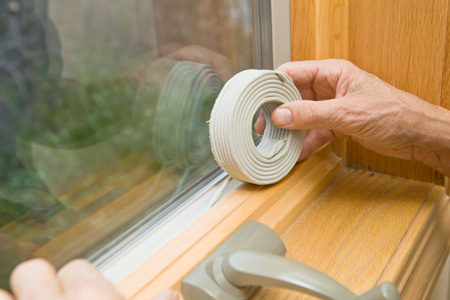
Regardless of whether you optimistic or pessimistic about today’s economy, everybody likes to save
money when they can. One of the largest recurring expenses that we actually have some control over is
our household energy bill. While there is nothing we can do about the seasonal weather changes, we do
have some control over how much it costs us to keep our homes comfortable during the seasonal
extremes.
Heating and cooling costs account for nearly half of the energy expenses wasted at home. Even minor
gaps, and cracks in the seals around your window and door openings can lead to significant interior air
loss, thereby increasing the need to use energy to heat and cool your home. As a result, household
energy consumption increases, thus flushing more money down the drain. However, there is an answer to
solve this problem – home weatherization.
Home weatherization is the practice of keeping the outside elements, e.g., sunlight, water precipitation,
and air, from entering your home, while keeping the interior air in. Home weatherization always begins by
focusing the most inefficient parts of your home: your windows and doors. To help you begin
weatherizing your home, here are some simple and affordable do-it-yourself ways to seal your windows
and doors.
To begin with, all the windows and doors of your home should be checked to see if there are unwanted
air currents coming from your windows and doors. A simple method is to slowly move a candle around the
perimeter of your windows and doors, and watching for the flame to flicker. It’s best to do this when
there’s at least a little wind outside. Once a draft is detected, you’ll want to determine if the draft is
coming through the window frame (between the operable portion of the window and the frame that holds
it), or around the window frame (between the main window frame and drywall or wood trim).
If you determine the draft is coming through the frame, the most likely cause is worn or damaged
weather-stripping. Open the window or door and inspect the seals around the perimeter for any gaps,
cracks or missing stripping. It can be difficult to find the exact seals used by your window manufacturer,
but most hardware stores carry a variety of self-adhesive rubber and foam whether-stripping that will do
the trick. Doors on the other hand, typically use one of just a few types of whether-stripping that are
usually easy to find at your local hardware store.
Another possible cause of drafts that are coming through a window frame is that your window is not
closing properly. The most obvious signs of this are that the window is difficult to open and close, the
operable sash is sitting crooked in the frame, or the window will not, or is difficult to lock. If this is the
case, you’ll most likely want to contact a window repair company. In a bind, in either circumstance, you
can temporarily tape around the window frame to block any drafts that are coming through until you have
a chance to fix it properly. We recommend blue painters tape, as it’s easy to remove and won’t leave
messy adhesive on your window frames.
If it is determined that the drafts are coming around your window or door, the likely cause is gapped or
cracked caulking between the window or door frame and the exterior siding or stucco. You’ll want to
visually inspect the caulking between the exterior trim and the window or door frame, as well as the
caulking between the trim and the exterior siding or stucco. If there’s only minor gaps or voids, you can
simply fill them with a paintable siliconized acrylic caulk. If the caulking is peeling or cracking, it is
advisable to remove all of the old caulking and reapply new caulking. In this case a paintable siliconized
acrylic caulk is the easiest to work with, but you can get more life from a paintable polyurethane caulking
that is formulated for this use. (Please note that regular inspection and repair of the exterior caulking is
highly advisable even if no drafts are detected. Any voids in this caulking may lead to water intrusion and
much more serious problems down the road.) You’ll want to do these same steps on the interior,
inspecting the caulking between the window, window trim (if present) and the drywall. You can use a
basic acrylic caulk on the interior.
The last thing you’ll want to inspect is all of your glass units in your windows and doors. You’ll want to
look for cracked or failed glass units (glass that has moisture or fogging between the panes). The
moisture in these units conduct the heat and cold much more efficiently than dry air, and can result in a 5-
10 degree (F) difference in the surface temperature of the entire glass surface. Consider that the
moisture is typically present 24 hours a day, and you can understand what a difference even a single
failed unit can make in the comfort level of that room…not to mention your energy bill over the course of a
month.

